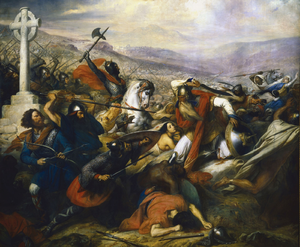Our website is made possible by displaying online advertisements to our visitors.
Please consider supporting us by disabling your ad blocker.
Umayyad invasion of Gaul
This article includes a list of general references, but it lacks sufficient corresponding inline citations. (May 2018) |
| Umayyad invasion of Gaul | |||||||||
|---|---|---|---|---|---|---|---|---|---|
| Part of early Muslim conquests and the Reconquista | |||||||||
 1837 painting by Charles de Steuben of the Battle of Tours (732), depicting a triumphant Charles Martel (mounted) facing Abd al-Rahman al-Ghafiqi (right). | |||||||||
| |||||||||
| Belligerents | |||||||||
|
Francia Aquitaine Gascony Lombard Kingdom | |||||||||
| Commanders and leaders | |||||||||
|
Al-Samh ibn Malik al-Khawlani † Abd al-Rahman al-Ghafiqi † Yusuf ibn Abd al-Rahman al-Fihri | |||||||||
The Umayyad invasion of Gaul, also known as the Islamic invasion of Gaul, refers to a series of military campaigns by Muslim forces to expand their territory into the region of Gaul (roughly modern-day France) following the Umayyad conquest of the Iberian peninsula (711-718). The Umayyad invasion occurred in two phases, in 719 and 732 AD. Although the Umayyads secured control of Septimania, their incursions beyond this into the Loire and Rhône valleys failed. In 759, Muslim forces lost Septimania to the Christian Frankish Empire and retreated to the Iberian Peninsula which they called al-Andalus.
The 719 Umayyad invasion of Gaul was the continuation of their conquest of the Visigothic Kingdom of Hispania. Septimania, in southern Gaul, was the last unconquered province of the Visigothic Kingdom.[1] The incursion into Septimania was motivated by the need to secure their Iberian gains. Muslim armies began to campaign in Septimania in 719. After the fall, in 720, of Narbonne, the capital of the Visigothic rump state, Umayyad armies composed of Arabs and Berbers turned north against Aquitaine. Their advance was stopped at the Battle of Toulouse in 721, but they sporadically raided southern half of Gaul as far as Avignon and Lyon.[1]
A major Umayyad raid directed at Tours was defeated in the Battle of Tours in 732. After 732, the Franks asserted their authority in Aquitaine and Burgundy, but only in 759 did they manage to take the Mediterranean region of Septimania, due to Muslim neglect and local Visigothic disaffection.[1]
After the fall of the Umayyad Caliphate and the rise of the Abbasid Caliphate in 750, internal conflicts within al-Andalus, including revolts and the establishment of the Emirate of Córdoba under Abd al-Rahman I, shifted the focus of Andalusi Muslim leaders towards internal consolidation. However, sporadic military expeditions were still launched into Gaul. Some of these raids resulted in temporary Muslim settlements in remote areas, but they were not integrated into the emirate's authority and soon vanished from historical records.
A later Muslim incursion into Gaul, in the ninth century, resulted in the establishment of Fraxinetum, a fortress in Provence that lasted for nearly a century.
- ^ a b c Watson 2003, p. 1.
Previous Page Next Page
الفتح الإسلامي للغال Arabic فتح الغال ARZ উমাইয়াদের গল আক্রমণ Bengali/Bangla Invasió musulmana de la Gàl·lia Catalan Fränkisch-arabischer Konflikt German Invasión musulmana de la Galia Spanish تهاجم امویان به گل FA Invasion omeyyade en France French Invasi Galia oleh Umayyah ID ウマイヤ朝のガリア侵攻 Japanese


